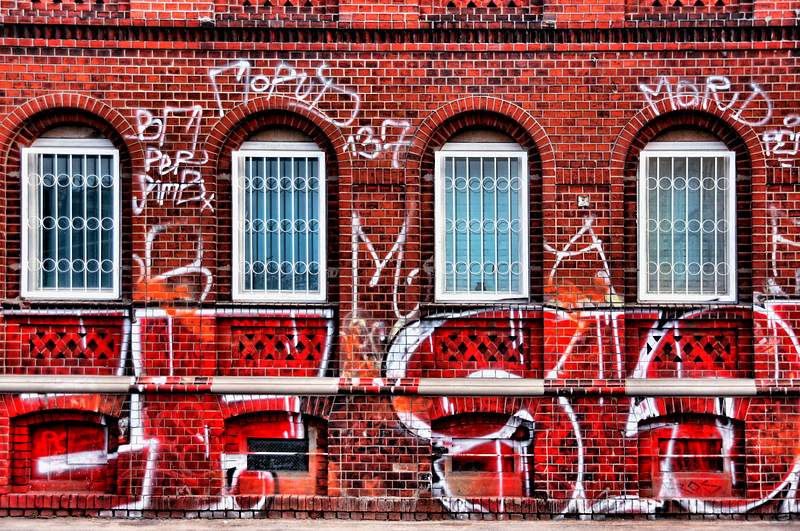Is that fresh graffiti bringing down the look of your property? Fear not! You can reclaim your pristine walls with some know-how and elbow grease. Graffiti removal is all about understanding the type of surface you’re dealing with and using the appropriate removal techniques. It might seem intimidating, but we’re here to guide you through the process.
Short Tips:
- Materials needed: A graffiti removal project will typically require the following items:
- Cleaning solution or graffiti remover (e.g., Krud Kutter Graffiti Remover, Goof Off Graffiti Remover)
- Soft-bristled brush or scrub pad
- Clean cloth or rag
- Safety goggles and gloves for protection
- Test on a small area: Before applying the graffiti remover to the entire surface, test it on a small, inconspicuous area to ensure it doesn’t damage the underlying material.
- Follow manufacturer’s instructions: Read and follow the instructions on the graffiti remover product label carefully.
- Apply the graffiti remover: Apply the graffiti remover to the affected area according to the instructions. Allow it to penetrate the graffiti for the recommended time.
- Scrub gently: Use a soft-bristled brush or scrub pad to gently scrub the graffiti without damaging the surface beneath.
- Wipe or rinse: Wipe away or rinse off the graffiti remover and residue with a clean cloth or water.
- Repeat if necessary: For stubborn graffiti, you may need to repeat the process several times.
- Protective coatings: Consider applying a protective coating or anti-graffiti sealant after removing the graffiti to make future removal easier (e.g., Graffiti Shield Protective Coating).
Identifying the Surface
Before you start, it’s essential to identify what kind of surface you’re dealing with.
Porous Surfaces
Porous surfaces like brick, concrete, or untreated wood absorb paint, making graffiti removal more challenging. These surfaces require a more intensive approach, often involving specialized cleaners and techniques.
Non-Porous Surfaces
On the other hand, non-porous surfaces, such as metal, glass, or painted walls, typically resist the absorption of paint. Graffiti on these surfaces can be easier to remove, often with less aggressive techniques and solutions.

Techniques for How to remove graffiti spray paint from different surfaces
There are several approaches to graffiti removal, each suited to different situations and surfaces.
Chemical-based Removal
Commercial graffiti removers are available on the market that can dissolve or weaken the paint for easy removal. They are typically effective on both porous and non-porous surfaces.
DIY Home Remedies
For those who prefer a more natural approach, several home remedies can be surprisingly effective. A simple mixture of warm water, vinegar, and a touch of dish soap can work wonders on certain surfaces.
Abrasive Techniques
- Sandblasting is a potent method for removing paint from porous surfaces. This technique involves blasting the surface with small particles to physically remove the graffiti.
- Soda blasting is a less abrasive option that uses baking soda particles. It’s especially useful on delicate surfaces where other techniques could cause damage.

Paint Over
In some instances, the best option might be to paint over the graffiti. This is usually an excellent solution when dealing with large areas of graffiti on painted surfaces.
Brick or Concrete
Because these surfaces are porous, they can absorb the paint, making removal more difficult.
- Use a power washer: If you have access to one, power washing with hot water can be effective. But be careful to avoid damaging the surface.
- Use a graffiti removal product: There are several on the market that are designed to break down spray paint. Follow the manufacturer’s instructions for use.
- Use a paint remover or solvent: Apply it to the graffiti, let it sit for a few minutes, then scrub the area with a stiff brush. Rinse the area with water.
Metal
Metal surfaces are non-porous, making them a bit easier to clean.
- Use a paint thinner or graffiti removal product: Apply it to the graffiti, let it sit for a few minutes, then wipe or scrub it off. Be sure to rinse the area well afterward.
- Use a power washer: If the graffiti is stubborn, power washing may be helpful.
Plastic
Plastic can be damaged by harsh chemicals or scrubbing.
- Use a mild detergent: Mix with warm water and apply it to the graffiti. Gently scrub the area with a soft cloth or sponge. Rinse well.
- If that doesn’t work, you can try a non-acetone nail polish remover or a graffiti removal product. Test it on a small area first to make sure it doesn’t damage the plastic.
Glass
Glass is non-porous and can handle stronger cleaning solutions.
- Use a razor blade to scrape off the graffiti. Be very careful not to scratch the glass.
- You can also use a paint thinner or graffiti removal product. Apply it to the graffiti, let it sit for a few minutes, then wipe or scrub it off. Rinse the area well.
Surface-Specific Graffiti Removal Methods
- Removing Graffiti from Brick and Concrete Surfaces
For brick and concrete, start by applying a commercial graffiti remover or an eco-friendly alternative. Scrub the surface gently with a brush or sponge. In extreme cases, consider using sandblasting, but this method should be handled by professionals due to its potential to cause surface damage.
- Removing Graffiti from Metal Surfaces
Avoid using abrasive materials on metal surfaces, as they can scratch the metal. Start with mild solvents or eco-friendly removers. For stubborn graffiti, switch to stronger commercial removers. Rinse the surface thoroughly and apply a protective coating after removal.
- Removing Graffiti from Wooden Surfaces
Wood is sensitive to harsh chemicals, so begin with eco-friendly removers or a mixture of baking soda and water. Gently scrub the graffiti, and if necessary, sand the area and repaint it once the graffiti is fully removed.
- Removing Graffiti from Glass Surfaces
Use a gentle graffiti remover designed for glass surfaces to avoid scratches. A glass polish or restoration product can help to achieve a clean finish.
- Removing Graffiti from Plastic Surfaces
Test any solvent on a small, inconspicuous area of the plastic before full-scale application. Use a soft cloth or sponge to remove the graffiti gently. Consider repainting or refinishing the plastic surface after removal.
Special Cases and Extra Tips
Graffiti Removal from Vehicles and Transportation
For vehicles, consider using automotive-specific graffiti removers or consult a professional detailer to handle the removal process without damaging the vehicle’s paint.
Graffiti on Sensitive Historical or Artistic Structures
In cases where graffiti is present on historical or artistic structures, consult with preservation experts to ensure the removal process doesn’t harm the original material or paint.
Preventive Measures and Coatings to Deter Future Graffiti
Apply anti-graffiti coatings on vulnerable surfaces to make future graffiti removal easier and discourage vandals from targeting the area.
Seek Professional Services for Complex or Delicate Situations
For intricate or delicate surfaces or extensive graffiti, consider seeking professional graffiti removal services to ensure the best outcome without causing damage.
FAQs:
Q: How to remove graffiti spray paint from delicate surfaces?
A: Delicate surfaces like marble require gentle cleaning agents and soft brushes to avoid damage.
Q: Can vinegar remove graffiti from concrete walls?
A: Yes, vinegar can be effective in breaking down graffiti paint on concrete surfaces.
Q: How can I remove graffiti without chemicals?
A: Using a pressure washer or sandblasting are effective chemical-free options.
Q: Is it possible to remove graffiti without leaving any traces?
A: Yes, with the right methods and products, graffiti can be completely removed without leaving marks.
Q: Can graffiti be removed from a car without damaging the paint?
A: Yes, but it’s best to seek professional help to avoid paint damage.
Q: How can I protect my property from future graffiti attacks?
A: Applying anti-graffiti coatings or installing security cameras can be effective preventive measures.
Conclusion
By following these comprehensive guidelines, you can confidently tackle graffiti removal from different surfaces while maintaining their integrity and aesthetics. Prompt and effective removal not only improves the appearance of the affected area but also sends a clear message that graffiti vandalism will not be tolerated.
Remember to use appropriate safety measures and choose the right removal method based on the surface type to achieve the best results. Let’s work together to preserve our communities and public spaces by taking responsible actions against graffiti vandalism.
Ruth Aquilani is a renowned graffiti artist known for her bold, colorful, and expressive style. She began her career as a street artist in the early 2000s, quickly making a name for herself in the graffiti community with her unique and striking works of art.
